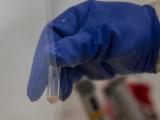Oct 25 (CIDRAP News) Two studies published online by Nature this week help explain how anthrax toxin works, possibly paving the way for the development of drugs that could block the toxin's action. One group of researchers explains how it identified the cell-surface receptor that enables anthrax toxin to invade host cells, while another group describes the precise molecular structure of a key component of the toxin.
The reports are scheduled for print publication in the Nov 8 issue of Nature, but the journal published them early on the Internet because of the intense interest in anthrax raised by the recent attacks by mail. Anthony Fauci, director of the National Institute of Allergy and Infectious Diseases, was quoted in the general media Wednesday as saying that similar discoveries about HIV had quickly led to the development of AIDS drugs.
The anthrax toxin receptor was identified by Kenneth A. Bradley of the University of WisconsinMadison and associates from there and Harvard Medical School in Boston. Their report explains that the toxin has three componentsprotective antigen (PA) and two enzymes, called edema factor and lethal factor (LF). PA "binds to a cellular receptor and mediates delivery of the enzymatic components to the cytosol," where they attack the cell, the report says.
Bradley et al identified the PA receptor by using a "genetic complementation approach." This involved exposing cells in the laboratory to a mutagenic chemical in the hope that a resulting mutation would shut off the gene that encodes the receptor. They then exposed the surviving cells to anthrax toxin in order to identify those that were now immune because they no longer had the receptor. Next, they used viruses to inject different sections of human complementary DNA into the immune cells. One of the viruses canceled the cells' immunity to anthrax toxin, and this permitted the researchers to identify the gene that creates the PA receptor. Armed with this knowledge, the authors "cloned" the receptor.
The authors describe anthrax toxin receptor as "a type I membrane protein that contains a single von Willebrand factor A domain that binds directly to PA." They explain how they created a synthetic version of the receptor and found that it could be used in the lab to protect human cells from anthrax toxin. The synthetic version serves as a decoy that latches onto the toxin and keeps it from attacking cells, according to a report on Nature Science Update, a Web site associated with the journal.
The report on the structure of anthrax toxin LF was authored by Andrew D. Pannifer of the University of Leicester, United Kingdom, and colleagues from several centers in the United States. They describe LF as "a highly specific protease that cleaves members of the mitogen-activated protein kinase kinase (MAPKK) family near to their amino termini, leading to the inhibition of one or more signaling pathways." Three of the four domains that make up the LF molecule together form a "long deep groove that holds the 16-residue N-terminal tail of MAPKK-2 before cleavage," the article says. Knowledge of the molecule's structure "can be used in the design of therapeutic agents that would block the activity of LF in vivo," the article states.
Bradley KA, Mogridge J, Mourez M, et al. Identification of the cellular receptor for anthrax toxin. Nature 2001 Nov 8;414 [Full text]
Pannifer AD, Wong TY, Schwarzenbacher R, et al. Crystal structure of the anthrax lethal factor. Nature 2001 Nov 8;414 [Full text]




















